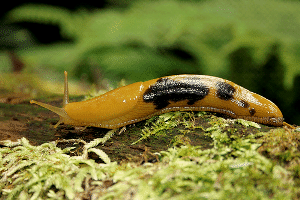9.1 斯克莱顿
章节大纲
-
The skeletal system consists of all the of the body. How important are your bones?
::骨骼系统由所有身体组成 你的骨骼有多重要?Try to imagine what you would look like without them. You would be a soft, wobbly pile of skin, , and internal organs , so you might look something like a very large slug. Not that you would be able to see yourself—folds of skin would droop down over your and block your because of your lack of skull bones. You could push the skin out of the way, if you could only move your arms, but you need bones for that as well!
::试想没有它们,你会长什么样。你会变成一个软软的、摇摆的皮肤,和内脏的堆积体,所以你可能看起来象一个非常大的子弹一样。你不会看到自己——因为你没有头骨,皮肤会滑倒,堵住你。你可以把皮肤推开,如果你能动手臂,但你也需要骨头的话!The Skeleton
::心箱How important is your skeleton? Can you imagine what you would look like without it? You would be a wobbly pile of muscle and internal organs, maybe a little similar to the slug in Figure . Not that you would be able to see yourself anyway, due to the folds of skin that would droop over your eyes because of your lack of skull bones. You could push the skin out of the way, if you could only move your arms!
::你的骨骼有多重要? 你能想象没有骨骼你会长什么样吗? 你会是一大堆肌肉和内脏, 可能和图中的子弹有点相似。 因为皮肤的折叠会因为你缺乏头骨骨而使你的眼睛滑过。你可以把皮肤推开,如果你能动手臂的话!Banana slugs ( Ariolimax spp.), unlike you, can live just fine without a bony skeleton. They can do so because they are relatively small, and their food source (vegetation) is plentiful and tends not to run away from them. Slugs move by causing a wave-like motion in their foot (the ventral (bottom) area of the slug that is in contact with the ground). Slugs and other gastropods also live in environments very different to human environments. Just think of how a bony skeleton would be of limited use to a slug whose lifetime is spent under a log munching on rotting leaf litter.
::与你不同,香蕉鼻涕虫(Ariolimax spp.)可以在没有骨骼骨骼的情况下过上很好的生活。它们可以这样做,因为它们相对小,食物来源(植被)丰富,往往不会逃离它们。 鼻涕虫在脚部(与地面接触的鼻涕虫的腹部(下部))引起波状运动而移动。 鼻涕和其他胃毛也生活在与人类环境非常不同的环境中。 只需想一想一个骨骼骨骼对于一个一生都花在腐烂的树叶堆上的子弹来说,其用处会多么有限。Humans are vertebrates , which are that have a vertebral column , or backbone . Invertebrates , like the banana slug in Figure , do not have a vertebral column, and they use a different mechanism than vertebrates to move about. The sturdy internal framework of bones and cartilage that is found inside vertebrates, including humans, is called an endoskeleton . The adult human skeleton consists of approximately 206 bones, some of which are named in Figure . Cartilage, another component of the skeleton, can also be seen in Figure . Cartilage is a type of dense connective tissue that is made of tough fibers. The function of cartilage in the adult skeleton is to provide smooth surfaces for the movement of bones at a joint. A ligament is a band of tough fibrous tissue that connects bones together. Ligaments are not very elastic, and some even prevent the movement of certain bones.
::人类是脊椎动物,是脊椎动物,有脊椎动物,有脊椎动物,有脊椎动物,有脊椎动物,有脊椎动物。脊椎动物,如图中的香蕉,没有脊椎动物,没有脊椎动物,他们使用与脊椎动物不同的机制来移动。脊椎动物(包括人类)内发现的骨骼和软骨浆的坚固内部框架称为内骨骼骨骼;成年人体骨骼约有206个骨骼,其中一些在图中有所命名。骨骼的另一部分是软骨骼。软骨骼是一种由硬纤维制成的稠密连接组织。成年骨骼中的软骨骼功能是给骨骼运动提供光滑的表面。一块坚硬的纤维组织将骨骼连接在一起。软骨骼并非非常弹性,有些甚至阻止某些骨骼的移动。The skeletons of babies and children have many more bones and more cartilage than adults have. As a child grows, these “extra” bones, such as the bones of the skull (cranium) and the sacrum (tailbone), fuse together, and cartilage gradually hardens to become bone tissue.
::婴儿和儿童的骨骼比成年人的骨骼多得多,软骨也多得多。 随着孩子的成长,这些“外”骨骼,比如头骨(头核)和骨架(尾骨)的骨骼、结合的保险丝和软骨逐渐硬化成为骨骼组织。The skeleton is the bone and cartilage scaffolding that supports the body and allows it to move. Bones act as attachment points for the muscles and tendons that move the body. Bones are also important for protection. For example, your skull bones (cranium) protect your brain, and your ribcage protects your heart and lungs. Cartilage is the light-gray material that is found between some of the bones and also between the ribcage and sternum.
::骨骼是骨骼和软骨支架,支撑身体并允许其移动。骨骼是肌肉的依附点和移动身体的支架。骨骼对于保护身体也很重要。例如,头骨(脊椎)保护你的大脑,肋骨保护你的心脏和肺部。软骨是一些骨骼之间以及肋骨和胸骨之间发现的轻光材料。The bones of the skeleton can be grouped into two divisions: the axial skeleton and appendicular skeleton. The axial skeleton includes the bones of the head, vertebral column, ribs, and sternum and is shown in the right portion of Figure . There are 80 bones in the axial skeleton. The appendicular skeleton includes the bones of the limbs (arms and legs) along with the scapula and the pelvis. It is shown on the left in Figure . There are approximately 126 bones in the appendicular skeleton. Limbs are connected to the rest of the skeleton by collections of bones called girdles. The pectoral girdle consists of the clavicle (collar bone) and the scapula (shoulder blade). The pelvic girdle consists of two pelvic bones (hipbones). The vertebral column attaches to the top of the pelvis; the femur of each leg attaches to the bottom. The humerus is joined to the pectoral girdle at a joint and is held in place by muscles and ligaments.
::骨骼的骨骼可以分为两个部分:轴骨和侧骨。轴骨包括头、脊椎柱、肋骨和胸骨的骨骼,在图的右部分显示。轴骨有80个骨骼。侧骨骨包括肢体的骨骼(手臂和腿)以及骨盆和骨盆。在图左侧显示的是。侧骨骨中大约有126个骨骼。骨骼与骨骼的其余部分相连,骨骼的集合被称为刺骨。骨的骨骼结为骨骼(脊椎骨)和骨(肩骨刀骨),骨骨螺包括两根骨骨骨骨(脊椎),脊骨柱附在骨盆的顶部;每条腿的骨骼附在底部。骨与骨骼连接在一起,并被肌肉和颈固定在一处。The two divisions of the human skeleton. The bones of the axial skeleton are blue, and the bones of the appendicular skeleton are pink.
::人类骨骼的两部分 轴骨的骨头是蓝色的 外形骨骼的骨头是粉红色的Summary
::摘要-
Children are born with significantly more bones and cartilage than adults; the cartilage hardens to become bone, and smaller bones fuse together to become the 206 adult bones.
::儿童出生时的骨骼和软骨比成年人多得多;软骨硬化成骨头,小骨骼合在一起成为206根成年骨头。 -
There are two parts of the human skeleton - the axial and appendicular skeletons.
::人类骨骼有两部分 轴心骨和附体骨骼
Review
::回顾-
What is the axial skeleton?
::什么是轴骨架? -
What is the appendicular skeleton?
::辅助骨骼是什么? -
What purpose does cartilage serve? Ligaments?
::软骨有什么用?
-
Children are born with significantly more bones and cartilage than adults; the cartilage hardens to become bone, and smaller bones fuse together to become the 206 adult bones.



